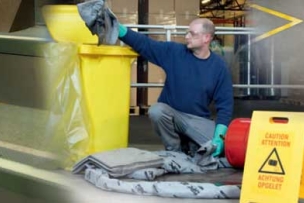The expense of protecting workers can seem steep, but noncompliance with safety rules and regulations ultimately can result in a deeper financial toll on a business. Rather than think of safety training as a cost, here’s why to think of it as an investment.
When it comes to keeping your workers safe, there are costs associated with facility safety gear and personal protective equipment. There are also the costs of paying fees and fines for noncompliance. It’s the intangibles of that noncompliance that can really gut a business: loss of employees, derailed productivity and missed business opportunities.
The National Safety Council’s most recent data, for 2017, puts the total annual costs due to preventable workplace injuries at $161.5 billion, which takes into account wage and productivity losses, medical expenses, administrative expenses, employers’ uninsured costs and the value of time lost by injured workers.
How Safety Training Boosts Safety ROI
Safety training is the most direct way to mitigate the risks of injuries, fines for noncompliance and the potential financial hit. What’s more, it’s critical to provide training early and often to your employees.
The injury and fatality data gathered by the Occupational Safety and Health Administration bear that out.
“We have known for decades that new workers, when they first start at a new job, are at greatly increased risk of injury—and we know why: New workers are often not adequately trained in the potential hazards at the new jobsite and the measures they can take to protect themselves,” says David Michaels, former OSHA administrator, as noted in an article in Safety+Health magazine.
OSHA has found that the risk of injury decreases with tenure, so repetition and diligence in training help both to insulate a business from safety incidents and to ensure compliance.
Recently released research by the Institute for Work & Health in Canada looked at 51 studies done over a period of 20 years into new workers and injury risks.
The IWH report concluded that there is value in early training and awareness programs: “Our review has potential implications for the prevention of work injuries, providing policy-makers and workplace parties with supportive evidence about the importance of prevention efforts focused on new workers, such as developing workplace policies that emphasize hazard exposure reduction, hazard awareness, hazard protection and worker empowerment.”
To achieve that desired culture of safety, businesses need to shift their mindset on safety, and think about it as an investment versus an operating expense. Here’s why: There’s an actual return on investment from spending on safety.
“I think that it’s important for the leadership to make sure that their safety people are listened to, and that there’s an environment that recognizes that safety is an important part of good business,” notes Ted Miller, principal research scientist with the Pacific Institute for Research and Evaluation, in Safety + Health magazine, “even if it slows work down a little bit at times … because then you don’t have incidents. Overall, you get more done at the end of the week.”
To figure out what injuries cost for your company, use our interactive Workplace Injury Cost Calculator. Bookmark the page today.





Talk to Us!
Leave a reply
Your email address will not be published. Required fields are marked *